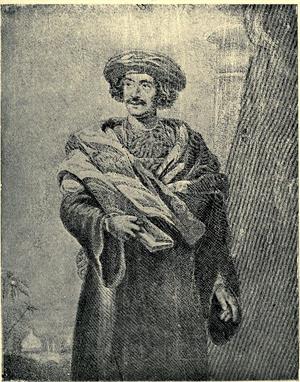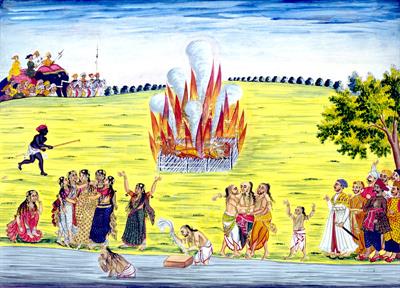PDF chapter test TRY NOW
4. Raja Ram Mohan Roy (1772-1833)
(Scene 1: Raja Ram Mohan Roy's conversation with a political member)
Narrator: Raja Ram Mohan Roy, a learned man from Bengal, understood what was wrong with the country.
Raja Ram Mohan Roy (to a political member): Let us not despise ourselves, our ancient culture is great. And we are capable of greater achievements. We must first reform our society. Superstitions have been ruining us.
(Scene 2: At Roy's house)
Narrator: He told his wife Uma–
Raja Ram Mohan Roy (told his wife): Cows are of different colours, but the colour of their milk is the same. Different teachers have different opinions but the essence of every religion is the same.
(Scene 3: Roy's meeting with common people)
Narrator: He was attracted by science and modern knowledge.
Raja Ram Mohan Roy: Knowledge should be practical and scientific.
Narrator: He started newspapers but the suspicious British stopped them in 1823.
(Scene 4: In England)
Narrator: He crossed the seas and went to England to see what made the British powerful. There he told them–
Raja Ram Mohan Roy (to the Britishers): We accept you as rulers, and you must accept us as subjects. But you must remember the responsibility a ruler owes to his subjects.
Explanation:
Raja Ram Mohan Roy was a well-known educated man and a great social reformer. He came from Bengal. Roy understood there was something wrong with the country, and it was due to the arrival of the Britishers. Raja Ram Mohan Roy informed a fellow member that they must not consider themselves inferior or look down upon themselves. He believed that the ancient culture of Indians was great and the people were capable of more remarkable achievements. Raja Ram Mohan Roy thought that the first step was to change the society by destroying the false belief that the Britishers came to India to save them. It was the leading cause of all the problems.

Raja Ram Mohan Roy, a learned man from Bengal
One day, while Raja Ram Mohan Roy was having a conversation with his wife Uma, he told her that, "Cows are of different colours, but the colour of their milk is the same. So likewise, different teachers might have different opinions, but the essence of each religion remains the same." From these two statements, Raja Ram Mohan Roy conveyed that even though peoples are of different colours, their blood remains the same. The religions are compared to teachers here because both believes in imparting wisdom and knowledge. Though there are several gods and religions around us, Raja Ram Mohan Roy believed that the essence remained the same in all of them.
Later on, Raja Ram Mohan Roy took a great interest in learning science and modern technology. According to him, learning should be practical and scientific. So Raja Ram Mohan Roy started to publish newspapers in India. Roy's newspapers were considered an important tool to criticize the anti-Indian and anti-people policies of the East India Company government. He also raised various demands to the government through his newspapers. However, the suspicious Britishers came to know about Roy's newspaper, and so they put an end to the newspaper in 1823.
Raja Ram Mohan Roy was very interested in knowing what made the Britishers more powerful, so he travelled across the seas and visited England. There, he met the Britishers and said that the Indians had accepted the Britishers as their rulers, and so they must accept the Indians as their subjects (followers or citizens). He added the point that the Britishers could not forget their responsibility and duty towards their country people. And also, Roy stated that the Britishers should know their subjects' goodness rather than destroying them.
Raja Ram Mohan Roy is mainly known for his efforts to abolish the practice of Child marriage and Sati. Sati or suttee was a historical Hindu practice in which a widow sacrifices herself by sitting at the top of her husband's funeral pyre.

Sati system
Meanings of the difficult words:
| S.No | Words | Meanings |
1 | Despise | Feel contempt |
2 | Achievement | A thing done successfully with effort, skill, or courage |
3 | Reform | Make changes in something, especially an institution or practice in order to improve it |
4 | Superstition | A widely held but irrational belief in supernatural influences, especially as leading to good or bad luck |
5 | Ruining | Cause a great damage or harm to; have a disastrous effect on something |
6 | Suspicious | Having or showing a cautious distrust of someone or something |
7 | Subject | A member of a state other than its ruler |
8 | Owe | Be under a moral obligation to give someone gratitude, and respect |
9 | Funeral pyre | A pile of wood on which a corpse is burnt as part of a funeral ceremony |
Reference:
National Council of Educational Research and Training (2008). Honeydew. Glimpses of the Past-S.D.Sawant(pp. 36-49). Published at the Publication Division by the Secretary, National Council of Educational Research and Training, Sri Aurobindo Marg, New Delhi.
https://commons.wikimedia.org/wiki/File:Raja_Rammohan_Roy.jpg#/media/File:Raja_Rammohan_Roy.jpg
https://commons.wikimedia.org/wiki/File:Sati_ceremony.jpg
